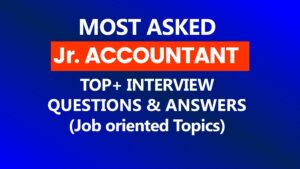Financial Planning and Analysis (FP&A) is a critical function that helps organizations make informed decisions by analyzing financial data, forecasting future performance, and managing budgets. Whether you are a fresher stepping into the finance world or an experienced professional looking to advance your career, preparing for an FP&A interview means understanding both technical concepts and real-world business scenarios. Interviewers often ask questions about financial statements, forecasting, budgeting, variance analysis, and financial modeling, along with situational questions to assess your problem-solving skills.
This blog covers essential FP&A interview questions and answers, including real-time examples and expert tips, to help you confidently navigate your interview and showcase your financial expertise.
Question: Can you describe your experience with financial analysis and how it has prepared you for this role?
Tip: Focus on what financial analysis means to you in practical terms and connect it directly to the skills needed for this specific role.
Answer: “For me, financial analysis is really about digging into the numbers to understand the story they’re telling about a business. I’ve spent a good chunk of my career doing just that – whether it was analysing company performance to identify areas for improvement, evaluating investment opportunities, or assessing risks. It’s like being a financial detective. One of my key contributions was identifying inefficiencies in operational costs, which helped reduce expenses by 10%.
This hands-on experience in financial analysis has strengthened my ability to forecast financial performance, streamline budgeting processes, and support strategic planning—making me well-prepared for this role.”
Question:What financial modelling techniques are you most comfortable with, and can you provide an example of a model you’ve built?
Tip: Mention key modeling techniques like three-statement modeling, sensitivity analysis, or DCF. Provide a real-world example.
Answer: “I’m quite comfortable with a range of financial modelling techniques. Specifically, I frequently use discounted cash flow (DCF) analysis for valuations, sensitivity analysis to test different scenarios and understand key drivers, and forecasting models using time-series data. For example, in my previous role, I built a three-statement financial model for a potential acquisition target in the [mention industry, e.g., ‘renewable energy’] sector.
This model projected their financials over five years, incorporating different growth scenarios and funding options. It allowed us to assess the deal’s viability and negotiate a fair valuation. I found building that model particularly rewarding as it directly informed a significant business decision.”
Question: Describe your experience with preparing P&L statements, balance sheets, and cash flow reports.?
Tip: Demonstrate your ability to work with financial statements and explain their significance.
Answer: “Preparing P&L statements, balance sheets, and cash flow reports is fundamental to understanding a company’s financial health, and it’s something I’ve done regularly throughout my career. To me, they’re not just compliance documents – they’re vital tools for assessing performance and making informed decisions. I’ve prepared these statements monthly and quarterly, ensuring accuracy and consistency.
Beyond just preparation, I’ve also used them extensively for analysis. For instance, when reviewing monthly P&Ls, I’d look for variances against budget to identify areas where costs were exceeding expectations or revenue was lagging. This proactive approach helped the team address issues quickly and stay on track.”
Question:Tell me about a time you developed a forecast. What methodologies did you use?
Tip: Highlight the methodology (historical trends, bottom-up, top-down, etc.) and the impact of your forecast.
Sample Answer:
“In my last role, I was tasked with forecasting quarterly revenue for a new product launch. I used a bottom-up approach, analyzing past sales data, customer trends, and market conditions. I also conducted sensitivity analysis to account for potential risks. The forecast helped the leadership allocate resources effectively and resulted in a 12% increase in revenue projection accuracy.”
Question:Can you explain the financial planning process?
Tip: Think of it as a cycle or a series of logical steps. Keep it high-level, focusing on the main stages and the overall goal of financial planning.
Answer: “In simple terms, the financial planning process is a roadmap that helps an organization define its financial goals and figure out how to achieve them. I see it as a cyclical process with a few key stages. It typically starts with defining clear financial objectives – what are we trying to achieve? Then, it moves into analysing the current financial situation – where are we starting from? Next comes developing a financial plan or strategy – outlining the actions needed to reach those goals.
This is followed by implementation – putting the plan into action. And crucially, it’s not a one-off – it’s about ongoing monitoring and review. We need to track progress, adapt to changes, and make adjustments to the plan as needed. The ultimate aim is to ensure the organization is financially sound and can achieve its strategic objectives.”
Question: What is the difference between FP&A and accounting?
Tip: FP&A is about future planning and analysis, while accounting focuses on recording and reporting past financial transactions.
Sample Answer: FP&A (Financial Planning and Analysis) is primarily concerned with forecasting, budgeting, and strategic planning to guide a company’s financial future. In contrast, accounting deals with the accurate recording of financial transactions, preparing financial statements, and ensuring compliance with regulations. While FP&A looks forward to help make informed decisions, accounting looks back to provide a clear picture of past performance.
Question: Can you walk me through a budget preparation process?
Tip: Mention key steps like gathering data, setting assumptions, preparing projections, and reviewing.
Answer:
“Budget prep usually starts with high-level guidance from leadership – what are the overall company goals for the year? Then, it’s a bit of a collaborative process. We’d typically distribute budget templates to department heads, asking them to build their needs bottom-up based on their objectives. FP&A plays a key role in providing historical data and assumptions to guide them. Once we get those initial budgets back, we consolidate and analyze them, looking for gaps, overlaps, and ensuring they align with the overall company goals. There’s usually some back-and-forth, some negotiation, and then we finalize, present, and monitor the budget throughout the year, making adjustments as needed. It’s definitely not a one-time thing, it’s an ongoing cycle.”
Question: Can you Explain the concept of EBITDA and its significance.
Tip: Keep the definition simple: earnings before interest, taxes, depreciation, and amortization. Focus on its use for profitability and comparisons.
Answer: EBITDA stands for Earnings Before Interest, Taxes, Depreciation, and Amortization. Basically, it’s a way to look at a company’s core operating profitability before you factor in things like how they finance themselves (interest), taxes which can vary, and non-cash accounting charges like depreciation. Its significance is that it gives you a cleaner picture of how profitable a company is from its actual business operations, regardless of their capital structure or tax situation. It’s often used to compare the profitability of different companies, especially when they might have very different levels of debt or operate in different tax jurisdictions.”
Question: Can you explain variance analysis and its importance in FP&A?
Tip: Variance analysis compares actual vs. budgeted performance to identify financial gaps and improve decision-making.
Answer:
“Variance analysis helps organizations understand why actual results differ from the budget. It involves breaking down revenues and expenses, identifying key drivers of deviation, and making adjustments to improve future forecasts. In my experience, performing variance analysis has helped management quickly address cost overruns and optimize resource allocation.”
Question: What is a cash flow statement, and why is it important in financial planning?
Tip: A cash flow statement is essential for understanding liquidity and ensuring a business can meet its obligations.
Answer: “A cash flow statement, simply put, tracks where cash is coming from and where it’s going in a business over a period of time. It categorizes cash flows into three main activities: operating, investing, and financing. It’s incredibly important in financial planning because profit isn’t the same as cash. You can be profitable on paper but still run out of cash if, for example, your customers are slow to pay or you have big upfront investments.
The cash flow statement helps us understand the company’s liquidity – can it meet its short-term obligations? Is it generating enough cash to fund its growth? Without a healthy cash flow, even a profitable business can struggle, so it’s a critical tool for ensuring financial stability and making sound financial plans
Question: How is Cash Flow Different from Free Cash Flow (FCF)?
Tip: Cash flow measures the total cash generated or used, while free cash flow focuses on cash available after necessary investments.
Sample Answer: Cash flow refers to the total movement of cash into and out of a business over a specific period, encompassing all cash transactions. Free Cash Flow (FCF), on the other hand, is the cash generated by operations after accounting for capital expenditures needed to maintain or expand the asset base. FCF is significant because it indicates how much cash a company has available for distribution to shareholders, debt repayment, or reinvestment after covering its operational costs and necessary investments.
Question: What are the main financial statements used in FP&A, and how are they connected?
Tip: The Income Statement, Balance Sheet, and Cash Flow Statement are interrelated and provide a full picture of financial health.
Answer:
“The three main financial statements we use constantly in FP&A are the Income Statement, Balance Sheet, and Cash Flow Statement. They’re all interconnected and tell different parts of the financial story. The Income Statement shows profitability over a period – revenue, costs, and profit. The Balance Sheet is a snapshot at a point in time – assets, liabilities, and equity. The Cash Flow Statement, as we discussed, tracks cash movement. They’re connected because the net income from the Income Statement flows into retained earnings on the Balance Sheet, and changes in balance sheet accounts drive parts of the Cash Flow Statement. They all work together to give a complete picture of a company’s financial health and performance.”
Question: What are the key components of a financial model?
Tip: A well-structured financial model should be flexible, clear, and easy to update.
Sample Answer: Key components of a financial model typically include:
- Assumptions: Key drivers and inputs that influence the model, such as growth rates, margins, and costs.
- Income Statement Projections: Forecasts of revenues, expenses, and net income.
- Balance Sheet Projections: Future estimates of assets, liabilities, and equity.
- Cash Flow Projections: Detailed cash inflows and outflows, including operating, investing, and financing activities.
- Valuation Analysis: Methods to assess the company’s value, such as Discounted Cash Flow (DCF) analysis.
- Sensitivity Analysis: Scenarios to test how changes in assumptions impact financial outcomes.
Question: What is your experience with automating financial reports and dashboards?
Tip: Highlight tools used (Excel, Power BI, Tableau, SQL, etc.) and the impact of automation.
Answer:
I have experience automating financial reports using Excel (macros, Power Query), Power BI, and SQL. In my last role, I built a dashboard that automated variance analysis and budget tracking, reducing manual work by 40%. Automating reports improves efficiency, minimizes errors, and allows real-time insights for better decision-making.
Question: Can you walk me through the three financial statements you commonly use and explain their importance?
Tip: Understanding how these statements interconnect is key to financial analysis.
Sample Answer:
- Income Statement: This statement starts with revenues and subtracts costs and expenses to arrive at net income. It reflects the company’s profitability over a specific period.
- Balance Sheet: At a specific point in time, the balance sheet lists assets, liabilities, and equity. It shows what the company owns and owes, with the fundamental equation being Assets = Liabilities + Equity.
- Cash Flow Statement: This statement reconciles net income from the income statement to cash generated or used during the period. It breaks down cash flows into operating, investing, and financing activities, providing insights into liquidity and cash management.
These three statements are interconnected; for example, net income from the income statement flows into the cash flow statement and affects retained earnings on the balance sheet.
Question: Can you explain ratio analysis to me?
Tip: Ratio analysis helps assess a company’s financial health and performance by comparing different financial metrics.
Sample Answer: Ratio analysis involves evaluating the relationships between various financial statement items to gain insights into a company’s performance and financial health. Common ratios include:
- Liquidity Ratios: Such as the current ratio and quick ratio, which assess a company’s ability to meet short-term obligations.
- Profitability Ratios: Like gross margin, operating margin, and return on equity (ROE), which measure how effectively a company generates profit.
- Leverage Ratios: Such as the debt-to-equity ratio, which indicates the level of debt used to finance the company’s assets.
- Efficiency Ratios: Like inventory turnover and accounts receivable turnover, which evaluate how well a company utilizes its assets.
By analyzing these ratios over time or against industry benchmarks, stakeholders can identify trends, strengths, and weaknesses in a company’s financial performance.
Question: What makes a “good” budget?
Tip: A good budget is realistic, flexible, aligned with company goals, and data-driven.
Answer:
“A good budget is realistic, based on historical data and market conditions, and aligned with business objectives. It should also be flexible to accommodate changes and incorporate variance analysis to track performance.
Question: Describe your experience with Excel. What advanced functions or features do you frequently use?
Tip: Mention advanced formulas, automation techniques, and data analysis tools.
Answer:
“I have extensive experience with Excel, especially in financial modeling, data analysis, and automation. Some key features I frequently use include:
- Advanced formulas (VLOOKUP, INDEX-MATCH, SUMIFS, IFERROR)
- Pivot Tables for data summarization and trend analysis
- Power Query for data transformation and automation
- Macros (VBA) for repetitive tasks and report automation
- Data visualization tools (charts, conditional formatting)
In one of my projects, I automated a financial reporting template using Power Query and Macros, reducing manual work by 50% and improving accuracy.”
Question: Describe your experience with financial audits. What aspects of financial practices do you typically review?
Tip: Mention compliance, accuracy, risk assessment, and internal controls.
Answer:
“I have worked on financial audits, focusing on compliance, internal controls, and financial accuracy. My responsibilities included:
- Reviewing financial statements for accuracy and adherence to GAAP/IFRS
- Analyzing internal controls to prevent fraud and errors
- Conducting variance analysis to identify discrepancies
- Ensuring proper expense classification and revenue recognition
For example, I once identified inconsistencies in expense reporting, which helped the company implement better tracking controls and improve financial transparency.”
Question: You mentioned PowerBI. Can you describe your experience using PowerBI for data visualization and reporting?
Tip: Focus on what you used Power BI for (dashboards, reports), specific features you utilized, and the positive outcomes (better insights, efficiency).
Answer:
“Yes, I’ve found Power BI to be a fantastic tool for bringing financial data to life. I’ve primarily used it to build interactive dashboards and automated reports. My experience includes:
- Building interactive dashboards for financial KPIs (e.g., revenue trends, cash flow analysis)
- Connecting data sources (Excel, SQL, cloud databases) for real-time updates
- Using DAX functions to create custom calculations for financial metrics
- Automating reports to improve decision-making
Question: How to Model Revenues for a Company
Tip: Use historical data and market trends to create realistic revenue projections.
Answer: To model revenues, start by analyzing historical sales data and identifying trends. Segment revenues by product lines or services, considering seasonality and market conditions. Incorporate growth assumptions based on market research, competitive analysis, and economic indicators. Use a top-down approach (market size) or bottom-up approach (unit sales) to project future revenues. Regularly update the model with actual performance data to refine accuracy.
Question: How do you assess financial risks in business planning?
Tip: Identify market, operational, and financial risks, then quantify their impact.
Answer:
“I assess financial risks by evaluating market volatility, cost fluctuations, liquidity concerns, and operational disruptions. Techniques like sensitivity analysis, scenario planning, and Monte Carlo simulations help quantify risks. For example, during a financial forecast, I performed stress testing to determine the impact of a 10% drop in sales, allowing us to develop contingency plans.”
Question: How to Model Operating Expenses for a Company?
Tip: Break down expenses into fixed and variable components for clarity.
Answer: To model operating expenses, categorize costs into fixed (e.g., rent, salaries) and variable (e.g., utilities, materials). Analyze historical expense data to identify trends and seasonality. Incorporate inflation and planned changes in operations, such as hiring or expansion. Use a line-item approach to project each expense category, ensuring alignment with revenue forecasts for a comprehensive view of profitability.
Question: What is the difference between budgeting and forecasting?
Tip: Budgeting is a fixed plan, while forecasting is a dynamic prediction.
Answer:
“Budgeting is a detailed financial plan for a set period, outlining expected revenues and expenses. It’s static and reviewed annually. Forecasting, however, is continuously updated based on real-time data and market changes. For example, while a budget may set annual expense targets, a rolling forecast helps adjust projections quarterly, ensuring agility in decision-making.”
Question: How to Model Working Capital for a Company?
Tip: Focus on the components of current assets and liabilities for accuracy.
Answer: To model working capital, analyze the components: accounts receivable, inventory, and accounts payable. Calculate the working capital requirement by estimating the cash conversion cycle, which includes days sales outstanding (DSO), days inventory outstanding (DIO), and days payable outstanding (DPO). Use historical data to project future working capital needs, ensuring alignment with revenue growth and operational changes. Regularly review and adjust the model based on actual performance.
Question: How do you ensure the accuracy and compliance of financial reports?
Tip: Use internal controls, reconciliations, and compliance checks.
Answer:
“I ensure accuracy by implementing internal controls, automated reconciliations, and variance analysis. I cross-check financial data against GAAP/IFRS standards and perform regular audits. In my previous role, I introduced an automated error-checking system, reducing reporting discrepancies by 30% and ensuring compliance with financial regulations.”
Question: How do you Approach to Forecasting Revenue and Expenses for a New Fiscal Year?
Tip: Use historical data and market analysis for informed projections.
Answer: When forecasting for a new fiscal year, I start by analyzing historical revenue and expense trends. I gather input from various departments to understand their expectations and needs. Market research and economic indicators help refine assumptions. I create multiple scenarios (best-case, worst-case, and most likely) to account for uncertainties. Finally, I regularly review and adjust forecasts based on actual performance and changing conditions throughout the year.
Question: What is the key revenue, bookings, and cost drivers for SaaS companies?
Tip: Focus on recurring revenue, customer lifecycle, and scalability.
Answer:
“For SaaS, recurring revenue is king – subscriptions are the lifeblood. Key revenue drivers include new customer acquisition (marketing efficiency), customer retention (churn rate), and expansion revenue (upselling/cross-selling). Bookings are a leading indicator of future revenue.
On the cost side, major drivers are customer acquisition cost (CAC) – how much to get a new customer, cost of service (COS) – infrastructure and support, and research & development to stay competitive. Understanding the customer lifetime value (CLTV) vs. CAC ratio is crucial for sustainable SaaS growth and profitability.”
Question: Describe a Challenging Financial Problem You Faced and How You Resolved It?
Tip: Highlight your problem-solving skills and analytical approach.
Answer: A challenging financial problem I faced was a significant revenue shortfall due to unexpected market changes. To resolve it, I conducted a thorough analysis of our sales pipeline and identified areas for improvement. I collaborated with the sales team to enhance lead generation and implemented targeted marketing campaigns. Additionally, I adjusted our expense forecasts to align with the new revenue projections. This proactive approach helped stabilize our financial position and set the stage for recovery.
Question: How to Prioritize Ad Hoc Requests Alongside Regular Responsibilities?
Tip: Use a structured approach to evaluate urgency and impact.
Answer: To prioritize ad hoc requests, I assess each request based on urgency and potential impact on business objectives. Maintain a clear communication channel with stakeholders to understand their needs and timelines. I categorize requests into high, medium, and low priority, focusing on those that align with strategic goals or have immediate deadlines. Also allocate specific time blocks in my schedule for ad hoc tasks, ensuring they don’t disrupt my regular responsibilities. This structured approach helps maintain productivity while addressing urgent needs.
—Ultimately, success in FP&A hinges on your ability to translate financial theory into practical application and to serve as a strategic partner to the business. By preparing for these real-time interview questions, relevant for both freshers and experienced professionals, you demonstrate your readiness to tackle the day-to-day challenges and contribute to the long-term strategic goals of the organization.
Use this guide to build your confidence and articulate your ability to provide meaningful financial insights that drive informed decision-making. With the right preparation, you can ace your interview and embark on a rewarding career as a key player in the world of finance.




